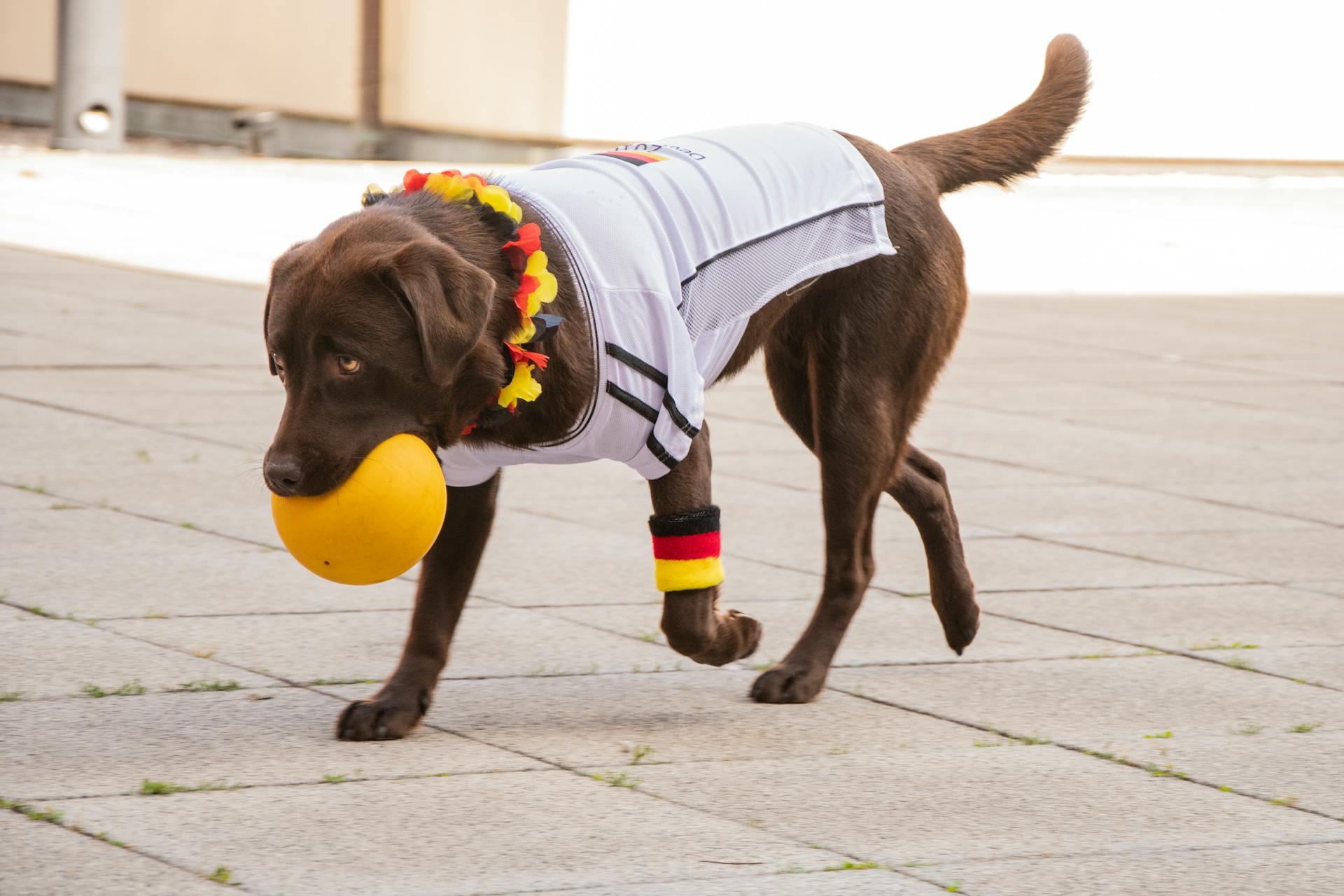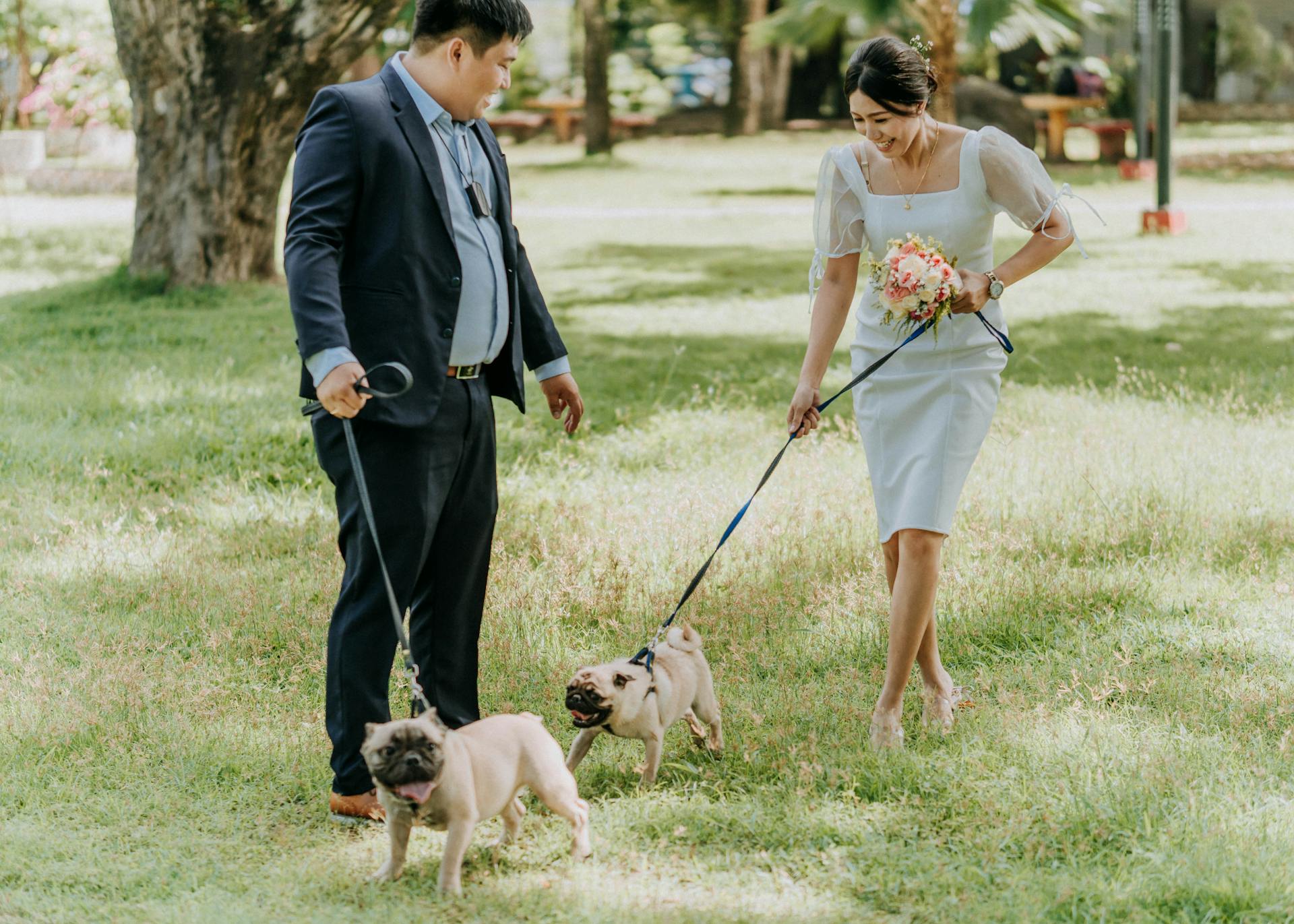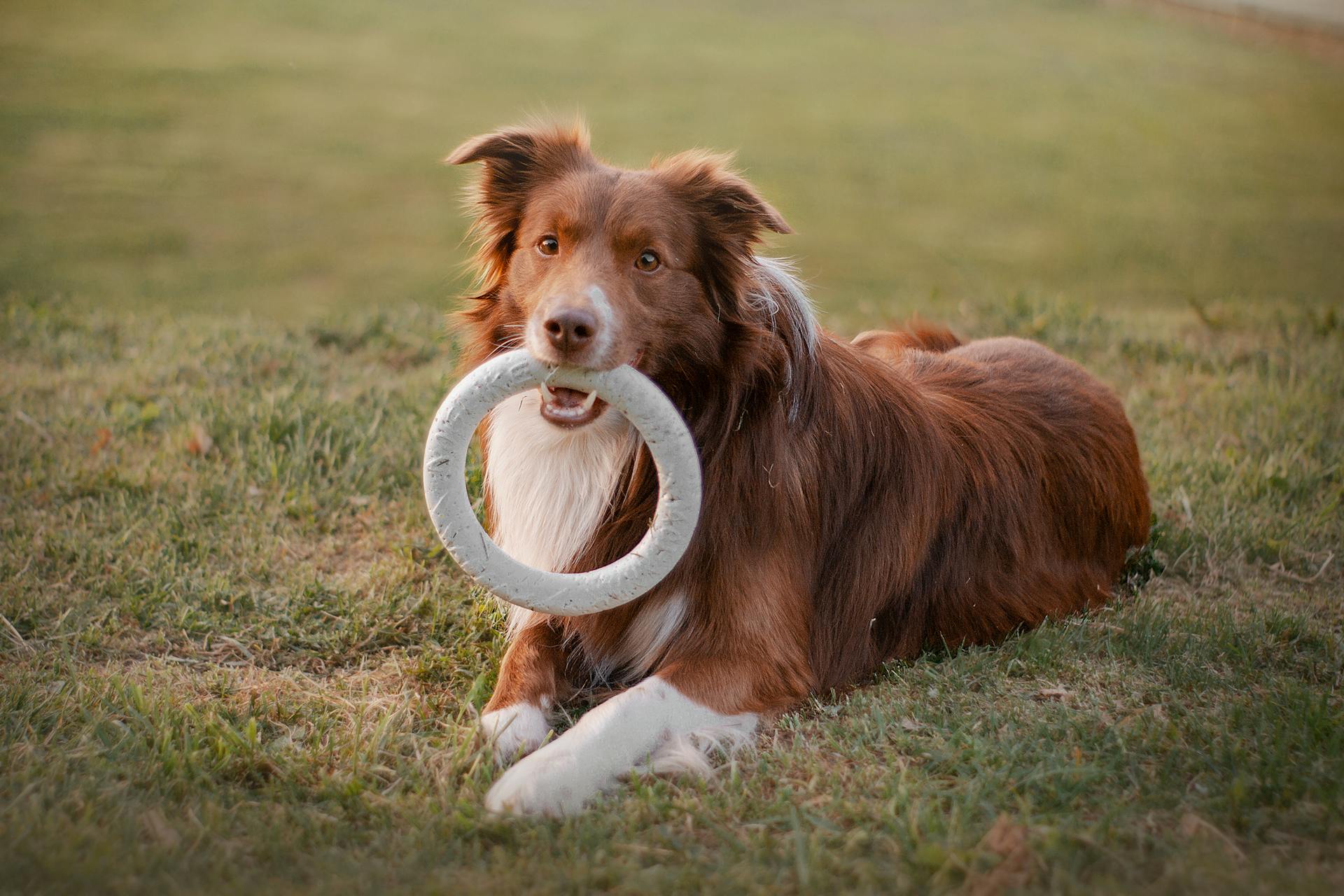
Labrador Retrievers are a high-energy breed that requires regular exercise to stay happy and healthy. They need at least 30 minutes of exercise per day, but ideally 1-2 hours.
Labradors are built for active lifestyles, with strong muscles and a water-resistant coat. They were originally bred to assist fishermen, so they're naturally inclined to love the water.
A daily walk or run is a great place to start, but it's not enough to satisfy their exercise needs. Labradors also need mental stimulation and playtime to prevent boredom and destructive behavior.
In addition to physical exercise, Labradors need regular breaks to rest and recharge. Puppies, in particular, need plenty of sleep to support their rapid growth and development.
Understanding Energy Levels
Labradors are born with a natural zest for life, and their energy levels can range from moderate to high, influenced by factors such as age, genetics, and overall health.
Puppies are notoriously high-energy, gradually mellowing as they mature, so it's essential to tailor an exercise regimen to their specific needs.
You might enjoy: Aussiedoodle Energy Level
Age plays a pivotal role in determining a Labrador's energy levels, with younger dogs requiring more physical and mental stimulation.
Labradors are bred to be versatile sporting dogs, possessing a robust physique and a tireless spirit that thrives on physical challenges.
Their genetic predisposition as sporting dogs underpins their need for purposeful daily activity to maintain optimal health and ward off boredom-induced mischief.
Labradors need a regimen that includes a spectrum of activities, ranging from vigorous runs to interactive play sessions, that tally up to an approximate 1 to 2 hours daily.
This targeted strategy not only stimulates their mental acuity but also fortifies their muscular prowess, enhancing overall vitality and longevity.
Each Labrador exhibits distinct preferences and capacities, so it's crucial to tailor routines to accommodate age, health status, and individual inclinations.
By doing so, you can create a bespoke fitness regime that optimally meets their distinctive needs and fosters a harmonious partnership.
Consider reading: My Dog Is Ruining My Mental Health
Exercise Types
Labrador Retrievers thrive on a variety of exercise types, including walking and running. Walking should be at least 30 minutes to an hour each day, with leash training to ensure a controlled and enjoyable experience.
For running, moderation is key, especially for younger dogs. Gradually introduce running into their routine, considering factors such as age and overall health, and opt for joint-supporting surfaces like grass or dirt trails.
A well-rounded exercise routine should also include interactive play sessions, agility drills, and aquatic jaunts, which stimulate mental acuity, muscular prowess, and emotional well-being.
Suggestion: Walking Dogs in Heat
Walking and Running
Walking and running are cornerstone exercises for Labrador Retrievers, contributing to physical fitness and mental stimulation.
Labradors need at least 30 minutes to an hour of walking each day, and leash training is essential for a controlled and enjoyable experience.
Choose varied routes to keep walks interesting for both you and your furry companion, and be mindful of signs of fatigue.
Consider reading: English Bulldog Walking
For running, moderation is key, especially for younger dogs. Gradually introduce running into their routine, considering factors such as age and overall health.
Optimal running surfaces are those that provide joint support, like grass or dirt trails. Ensure proper hydration during and after the run.
Labradors are well-suited for running, but be aware that they need joint support and should be hydrated properly during and after the run.
On a similar theme: Are Goldendoodles Good Running Dogs
Fetch and Retrieval
Fetch and Retrieval is a great way to engage your Labrador's natural instincts and provide physical exercise. Labradors have an innate love for retrieving, a trait deeply ingrained in their genes.
Playing fetch games provides more than just physical exercise, it also allows Labradors to channel their boundless energy positively. This can be a great way to calm them down and prevent destructive behavior.
You can use various toys, such as tennis balls or frisbees, to add variety to the game and keep your Labrador interested. Engaging in fetch games can enhance your Labrador's agility and strengthen the bond between you and your pet.
Teaching your Labrador to drop the retrieved item at your feet is an important obedience skill that reinforces your position as the leader. This can be achieved through leash training, which is crucial for a safe and controlled game.
Swimming can also be a great way to play fetch with your Labrador, especially if they love water. Just remember to start in shallow water and gradually move to deeper areas as their confidence grows.
Puppy Types
Labrador puppies under three months need exercise, and a certain amount of free running is a good thing.
Puppies require regular exercise to stay healthy and happy. In fact, a certain amount of free running exercise is beneficial for them.
Labradors are a popular breed, and their exercise needs vary depending on their age. Puppies under three months can start with short, gentle exercise sessions.
Exercise helps puppies develop physically and mentally. It's essential to introduce exercise gradually to prevent overexertion.
Free running exercise is beneficial for puppies, but it's essential to ensure they have enough rest time.
Expand your knowledge: German Shorthaired Pointer Free to Good Home
Exercise Safety
Labradors can push themselves beyond their limits, unaware of potential harm, so it's essential to recognize signs of overexertion.
Excessive panting, heavy drooling, reluctance to move, and an unsteady gait are all signs that your Labrador may be overexerted.
It's crucial to balance exercise intensity and duration to prevent fatigue. Introduce activities gradually, especially if your Labrador is new to a particular exercise.
Breaking up exercise sessions throughout the day can help prevent fatigue and provide ample opportunities for rest.
For another approach, see: Early Signs of Ivdd in Dachshunds
Daily Routine
Incorporating exercise into your Labrador's daily routine is essential for their physical and mental well-being.
Start the day with a brisk morning walk to energize your Labrador for the day, and end it with an evening walk to help them wind down.
Active play breaks throughout the day are also crucial, whether it's a quick game of fetch or a brief training session, these breaks prevent monotony and maintain their energy levels.
Interactive toys can be seamlessly integrated into their daily routine, providing mental stimulation during quieter moments.
As a general rule, Labradors need at least 15 minutes of exercise per day, with a ratio of five minutes exercise per month of age, up to twice a day, until they're fully grown.
Daily Routine Integration
Seamless Integration is key to making exercise a part of your daily routine. This ensures your Labrador receives consistent physical activity, contributing to their health and mental well-being.
Morning walks energize your Labrador for the day, while evening walks provide an opportunity to wind down. It's a great way to establish a positive routine.
Active play breaks throughout the day prevent monotony and maintain your Labrador's energy levels. A quick game of fetch or a brief training session can make a big difference.
Interactive toys can be used to stimulate your Labrador's mind during quieter moments. Place puzzle feeders strategically to keep them engaged.
For puppies under three months, free running exercise is a good thing. However, it's essential not to over-exercise them, as they tire quickly and may damage their developing joints.
Once your puppy reaches three months, you can start structured exercise. The five-minute rule is a good guideline: five minutes of exercise per month of age, up to twice a day.
What Type of Shirt Should I Get?
When it comes to dressing for the daily routine, consider a shirt that's comfortable for outdoor activities. Labradors love swimming, so a quick dip in the pool might be part of your daily routine.
A shirt that can withstand water splashes or accidental spills is a good idea. Playing fetch in the pool is a game your pet will adore.
A breathable, moisture-wicking fabric is perfect for post-run or post-play activities. After a game of tug-of-war or catch, you'll want a shirt that keeps you cool and dry.
A fun, casual design can add some personality to your daily routine. If you're playing fetch in the pool, you might want a shirt that's easy to move around in.
For another approach, see: Activities for Dogs with High Prey Drive
Training and Nutrition
Labradors need a balanced diet that meets their energy needs. A good quality dog food that is high in protein and fat is essential for their growth and maintenance.
Labradors require regular exercise to maintain a healthy weight and prevent obesity. According to the article, a Labrador's ideal weight is between 65-80 pounds, and regular exercise can help them achieve this weight.
A Labrador's daily caloric needs can vary depending on their age, size, and activity level. For example, an adult Labrador requires around 1,500-2,000 calories per day, while a puppy requires around 1,000-1,500 calories per day.
Signs of Insufficient Nutrition
If your Labrador is constantly chewing, barking, and digging, it's likely a sign they aren't getting enough exercise. This destructive behavior can be a result of excess energy and boredom.
If your Labrador is putting on excess weight and you're not over-feeding them, it's a clear indication they aren't getting enough physical activity. This can be a sign of underlying nutritional issues.
If your Labrador doesn't listen to commands they've been reliably trained to follow, it may be a result of insufficient exercise and mental stimulation. This can lead to behavioral problems and a strained relationship with your pet.
If your Labrador looks athletic and not overweight, it's a good sign they're being exercised enough. This can be a result of regular physical activity and a balanced diet.
Training Tips
Training is a crucial aspect of owning an active Labrador. Positive reinforcement is a great way to train your furry friend, as it responds exceptionally well to treats, praise, and affection.
Consistency is key when it comes to training sessions. Establish clear rules and expectations, and be consistent in enforcing them.
Active Labradors have boundless energy, which can be channeled into positive behaviors during training sessions. Teaching commands like "sit", "stay", and "come" provides mental stimulation and serves practical purposes.
Using positive reinforcement during exercise and play not only reinforces good behavior but also strengthens the bond between you and your Labrador.
A High Breed
Labradors were initially bred for physically demanding work, such as retrieving game for hunters. This involved all-day hiking, running, and swimming in challenging conditions.
Their original role required them to have lots of energy, which is still present in their genetics today. Labrador Retrievers have a body built for physical activity and one that craves it.
If you don't provide a way for them to release their pent-up energy, they may find a release for it themselves. This can be a problem if you don't have a suitable outlet for their energy.
One inexpensive toy for exercising Labs is the Chuckit! Dog Ball Thrower, which allows you to throw a tennis ball extra far without having to touch a slobbery ball.
If this caught your attention, see: Blue Heeler Energy Level
Frequently Asked Questions
What is the 5 minute rule for Labrador exercise?
The 5-minute rule for Labrador exercise recommends 5 minutes of exercise per month of age, so a 4-month-old Labrador should exercise for 20 minutes. This helps prevent overexertion and promotes healthy growth and development.
Sources
- https://blog.tryfi.com/labrador-retriever-exercise-needs/
- https://www.labradortraininghq.com/labrador-health-and-care/how-much-exercise-does-a-labrador-need/
- https://www.thelabradorsite.com/labrador-puppy-exercise-how-much-is-too-much/
- https://www.hepper.com/how-much-exercise-does-labrador-need-in-a-day/
- http://www.lovablelabradors.com/labrador-care/labrador-retriever-exercise-program-34/
Featured Images: pexels.com


